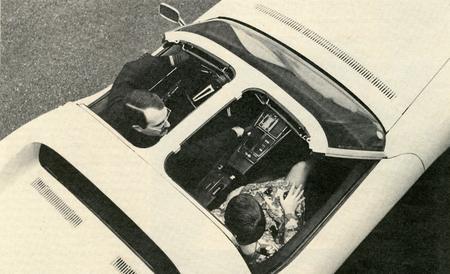Of course the champion of Corvette’s trick stuff parade has to be the take-apart roof. We’ve put off talking about it almost to the end because we can’t decide whether we like it or not. If you buy a coupe, it doesn’t cost anything extra and you don’t have to take it apart if you don’t want to so it can’t be too bad. With the pieces all assembled there were no extra rattles, shakes, or water leaks — just like driving a closed car except for all the latches and cut lines in the headliner. Assuming you like the idea of an occasional patch of daylight on top of your head the only real problem is what to do with the pieces after the disassembly operation. Two latches hold each panel and, in typical Corvette fashion, panels come out with ease. They’re meant to go into the trunk but if you’ve already got anything more than a bag of popcorn in there, forget it. A pair of giganto vinyl envelopes have been provided to protect the roof panels while they’re being stored. The plan then is to strap the packaged panels to the side walls of the truck compartment — actually they end up leaning on the wheel arches and take up a good bit of the available space. The back window clamps to a false roof that drops down from the top of the trunk compartment. Got that? Now all you have to do is snap the roof back up and that part is out of sight. Well, not really. The latch that holds the panel up is genuinely feeble and the result is that the whole business drops down whenever it feels a mind. Still, nobody says you have to take it apart and it didn’t cost extra — but it would be nice if it worked. Driving the open-air coupe is pleasant enough — with the side windows up there is almost no draft, even at speed, but in the back of your mind you’re thinking about putting everything back together when you get where you’re going.
Just criticism — and a good deal of it — can be leveled at the Corvette’s quality. The cheapest conceivable plastic knobs are used on the controls, unbound edges of carpet are visible around the seat tracks and at lap joints behind the seats, and the covering on the seats seldom fits smoothly. Corvette paint quality has always been poor — so thin in spots you can see the primer underneath. Yet this is the American automobile story. Luxury cars are assembled with the same materials and the same lack of care as compact sedans at half the price. Customers mumble about lack of quality but not loud enough so that the manufacturers really get worried. The Corvette is no better than a Camaro when it comes to quality and people buy them anyway. The result is an occasional car as bad at the Corvette we were given early last fall. ( C/D, Dec.) — and absolutely refused to test. Execrable quality control is a special shame on a car so well conceived as the ’68 Sting Ray. The contrast between good mechanicals and bad workmanship is devastating.
We’ve found things to criticize about the Corvette but over the years we’ve concluded the Sting Ray is better suited to the American scene than any other sports car in the world and at a price lower than you would have to pay for an E-type Jaguar, or a Porsche 911, or Toyota 2000 GT. The Corvette is not a copy of anything. It produces a whole new set of emotions in its beholders. It’s American and no other description begins to capture it. It’s big and why not? America has always demanded big cars — we’ve got plenty of space. Mechanically it feels unbreakable and it delivers a full measure of performance that its competitors can’t match at double the price. Handling is impeccable, limited only by street tires, and the Corvette’s pitch and float-free ride is ideally suited to high speed touring on American highways.
All of these automotive delectations are wrapped up in a package so boldly styled that no one can ignore it’s existence. The Corvette is a brilliant car with all of the virtues and all of the vices of American technology. On balance, it’s an almost irresistible temptation to buy American.
View Photos
View Photos


Leave a Reply